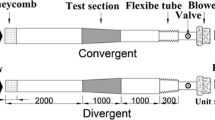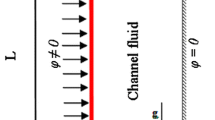Abstract
The present paper reports a numerical investigation of a forced convection water flow within a two-dimensional ribbed channel. A uniform heat flux is applied on the external walls. The flow regime is turbulent and Reynolds numbers are in the range 10·103÷100·103. Square and chamfered rib shapes with different arrangements are analyzed in terms of various dimensionless heights and pitches of elements. The investigation is accomplished by using a CFD code and its aim consists in finding of arrangements to obtain a high Performance Evaluation Criterion (PEC). Results are presented in terms of temperature and velocity fields, profiles of average Nusselt number, average heat transfer coefficients and required pumping power. Heat transfer enhancement increases with the ribs presence, but it is accompanied by an increasing pumping power. In particular, the best performances in terms of Nusselt are shown for p/e = 4 and 12 for both the square and chamfered cases. The heat transfer improves as Reynolds number raises, but a substantial increase of pumping power is also observed. The utilization of chamfered ribs allows to increase the PEC, especially at low Re. The maximum PEC is equal to 1.3 and it is obtained for Re = 104 and p/e = 4.











Similar content being viewed by others
Abbreviations
- a :
-
thermal diffusivity, m2/s
- cp:
-
specific heat, J/kg K
- d:
-
diameter, m
- e:
-
rib height, m
- f:
-
friction coefficient Eq. (10)
- H:
-
channel height, m
- L:
-
length, m
- k:
-
turbulent kinetic energy, m2/s2
- Nu:
-
Nusselt number Eq. (9)
- p:
-
rib pitch, m
- P:
-
pressure, Pa
- PEC:
-
performance evaluation criteria index Eq. (11)
- PP:
-
pumping power, W
- Pr:
-
Prandtl number
- q:
-
heat flux, W/m2
- Re:
-
Reynolds number Eq. (8)
- s:
-
channel thickness, m
- T:
-
temperature, K
- T*:
-
dimensionless temperature, T* = T/Tbulk
- u:
-
velocity component, m/s
- W:
-
channel width, m
- w:
-
rib width, m
- x, y:
-
spatial coordinates, m
- δ:
-
Kronecher delta function
- λ:
-
thermal conductivity, W/mK
- μ:
-
dynamic viscosity, Pa s
- ν:
-
kinematic viscosity, m2/s
- ρ:
-
density, kg/m3
- σ:
-
turbulent Prandtl number
- τ:
-
wall shear stress, kg/m2
- ω:
-
rate of dissipated turbulent kinetic energy
- a:
-
ambient
- avg:
-
average
- f:
-
fluid
- in:
-
inlet section
- m:
-
mass
- out:
-
outlet section
- s:
-
smooth
- T:
-
turbulent
- w:
-
wall
References
Bianco V, Manca O, Nardini S (2014) Performance analysis of turbulent convection heat transfer of Al2O3water-nanofluid in circular tubes at constant wall temperature. Energy 77:403–413. doi:10.1016/j.energy.2014.09.025
Lee CK, Abdel-Moneim SA (2001) Computational analysis of heat transfer in turbulent flow past a horizontal surface with two-dimensional ribs. Int Commun Heat Mass Transfer 28(2):161–170. doi:10.1016/S0735-1933(01)00223-8
Tanda G (2004) Heat transfer in rectangular channels with transverse and V-shaped broken riebs. Int J Heat Mass Transfer 47(2):229–243. doi:10.1016/S0017-9310(03)00414-9
Promvonge P, Thianpong C (2008) Thermal performance assessment of turbulent channel flows over different shaped ribs. Int Commun Heat Mass Transfer 35(10):1327–1334. doi:10.1016/j.icheatmasstransfer.2008.07.016
Promvonge P, Chompookham T, Kwankaomeng S, Thianpong C (2010) Enhanced heat transfer in a triangular ribbed channel with longitudinal vortex generators. Energy Convers Manag 51(6):1242–1249. doi:10.1016/j.enconman.2009.12.035
Kim HM, Kim KY (2004) Design optimization of rib-roughened channel to enhance turbulent heat transfer. Int J Heat Mass Transf 47(23):5159–5168. doi:10.1016/j.ijheatmasstransfer.2004.05.035
Kim KM, Kim BS, Lee DH, Moon H, Cho HH (2010) Optimal design of transverse ribs in tubes for thermal performance enhancement. Energy 35(6):2400–2406. doi:10.1016/j.energy.2010.02.020
Xie G, Zheng S, Zhang W, Sundén B (2013) A numerical study of flow structure and heat transfer in a square channel with ribs combined downstream half-size or same-size ribs. Appl Therm Eng 61:289–300. doi:10.1016/j.applthermaleng.2013.07.054
Viswanathan AK, Tafti DK (2006) Detached eddy simulation of turbulent flow and heat transfer in a two-pass internal cooling duct. Int J Heat Fluid Flow 27(1):1–20. doi:10.1016/j.ijheatfluidflow.2005.07.002
Labbè O (2013) Large-eddy-simulation of flow and heat transfer in a ribbed duct. Comput Fluids 76:23–32. doi:10.1016/j.compfluid.2013.01.023
Dritselis CD (2014) Large eddy simulation of turbulent channel flow with transverse roughness elements on one wall. Int J Heat Fluid Flow 50:225–239. doi:10.1016/j.ijheatfluidflow.2014.08.008
Tan L, Zhang JZ, Xu HS (2014) Jet impingement on a rib-roughened wall inside semi-confined channel. Int J Therm Sci 86:210–218. doi:10.1016/j.ijthermalsci.2014.06.037
Caliskan S, Baskaya S (2012) Experimental investigation of impinging jet array heat transfer from a surface with V-shaped and convergent-divergent ribs. Int J Therm Sci 59:234–246. doi:10.1016/j.ijthermalsci.2012.04.013
Yadav AS, Bhagoria JL (2014) A numerical investigation of square sectioned transverse rib roughened solar air heater. Int J Therm Sci 79:111–131. doi:10.1016/j.ijthermalsci.2014.01.008
Manca O, Nardini S, Ricci D (2012) A numerical study of nanofluid forced convection in ribbed channels. Appl Therm Eng 37:280–292. doi:10.1016/j.applthermaleng.2011.11.030
Bejan A, Kraus AD (2003) Heat transfer Handbook. Wiley
Baehr HD, Stephan K (2011) Heat and mass transfer, 3rd edn. Springer
Incropera FD, DeWitt DP, Bergman TL, Lavine AS (2006) Fundamentals of heat and mass transfer, 6th edn. Wiley
Rajasekaran J (2011) On the flow characteristics behind a backward-facing step and the design of a new axisymmetric model for their study. Master Degree Thesis, University of Toronto
Rajasekaran J, Lavoie P (2011) Effect of boundary layer thickness on separated shear layer behind a backward-facing step. In: CASI Aero
Driver DM, Seegmiller HL, Marvin JG (1987) Time-dependent behavior of a reattaching shear layer. AIAA j 25(7):914–919
Kim JJ (1978) Investigation of separation and reattachment of a turbulent shear layer ow over a backward-facing step. PhD thesis, Stanford Universtiy
Menter FR (1994) Two equation eddy-viscosity turbulence models for engineering applications. AIAA J 32:1598–1605
Tennekes H, Lumley JL (1972) A first course in turbulence. The MIT Press
Wilcox DC (1994) Turbulence modeling for CFD. DCW Industries
Pope SB (2014) Turbulent flows. Cambridge University Press
ANSYS FLUENT Theory Guide (2001) ANSYS Inc., Release 14.0
Webb RL, Kim NH (2006) Principles of enhanced heat transfer, second edn. Taylor & Francis Group, New York
Karwa R, Solanki SC, Saini JS (2001) Thermo-hydraulic performance of solar air heaters having integral chamfered rib roughness on absorber plates. Energy 26(2):161–176
Layek A, Saini JS, Solanki SC (2009) Effect of chamfering on heat transfer and friction characteristics of solar air heater having absorber plate roughened with compound turbulators. Renew Energy 34(5):1292–1298. doi:10.1016/S0360-5442(00)00062-1
Schlichting H, Gersten K (2000) Boundary layer theory. Springer-Verlag, Berlin
Elsaadawy E, Mortazaci H, Hamed MS (2008) Turbulence modeling of forced convection heat transfer in two-dimensional ribbed channels. ASME J Electron Packag 130(3):0310111–03101117. doi:10.1115/1.2912182
Saberinejad H, Hashiehbaf A, Afrasiabian E (2010) A study of various numerical turbulence modeling methods in boundary layer excitation of a square Ribbed Channel. World Acad Sci Eng Technol 71:338–344
Haque A, Ahmad F, Yamada S, Raza S (2007) Assessment of Turbulence Models for Turbulent Flow over Backward Facing Step. In: Proceedings of the World Congress on Engineering. Vol IIWCE 2007, July 2–4, 2007, London, UK
Author information
Authors and Affiliations
Corresponding author
Rights and permissions
About this article
Cite this article
Bianco, V., Borreani, W. & Lomonaco, G. Numerical investigation of turbulent flow within a channel with chamfered edge ribs in stream-wise direction. Heat Mass Transfer 53, 3211–3223 (2017). https://doi.org/10.1007/s00231-017-2078-4
Received:
Accepted:
Published:
Issue Date:
DOI: https://doi.org/10.1007/s00231-017-2078-4




